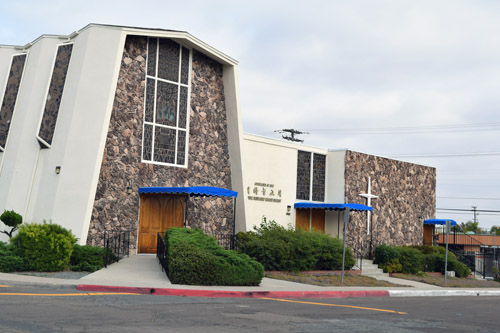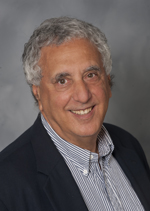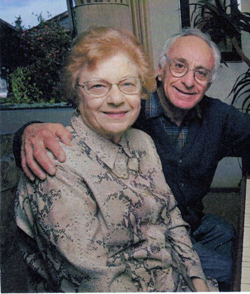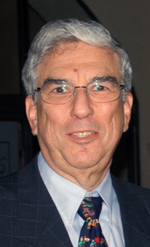
-38th in a series–
Exit 11, 70th Street, San Diego ~ Former Congregation Beth Tefilah
By Donald H. Harrison


SAN DIEGO – Today the structure at 69th and Mohawk Streets houses the Skyline Fellowship Korean Church but when it was constructed in 1971 it was the home of Congregation Beth Tefilah (House of Prayer), a Conservative Jewish congregation headed by Rabbi Samuel Penner, who was known not only as a spiritual leader but as a humorist and a scholar.
Penner worked closely with the architectural firm of Henry N. Miller & Associates to design the 600-seat A-shaped sanctuary that, in its triangular shape, paid homage to the portable Tabernacle that served Moses and the Israelites as they made their way through the Sinai. He was particularly involved in the designs of the congregation’s stained glass windows.
Twenty stained-glass windows, each 20 feet high, had scenes of Jewish history starting with Creation, and working its way through major incidents in the Torah, through experiences in Europe, to Jewish settlement in America, the founding of Israel, and the plight of Soviet Jews in the days when those wishing to emigrate routinely were refused permission and then treated like enemies of the state. Another two windows illustrated Shabbat and the cycle of Jewish holidays.
In fact, at the January 3, 1971, groundbreaking ceremony for this edifice, the Polish-born, Bronx-raised Penner contrasted the joy of Jewish life in the United States with the misery of Jewish life in the Soviet Union. Beth Tefilah’s construction, he said, “is symbolic of the right to speak out and demand justice in America.”
In addition to the sanctuary, the Beth Tefilah complex also contained a library, a facility for kosher receptions, and 10 classrooms. Education was a special concern of Rabbi Penner, who himself was a childhood prodigy, attending CCNY during his early teens, remembered Marlene Greenstein, who served as Beth Tefilah’s religious school principal.
Greenstein said a lower grade school and an upper grade school founded during Rabbi Penner’s administration were forerunners of such communal institutions as the San Diego Jewish Academy and Hebrew High School. She explained that Penner’s Conservative Synagogue was unable to sustain the two schools by itself—particularly when some of its students came from non-member families—but the enthusiasm Penner had created while they were open helped fuel the movement for permanent community institutions.
“Rabbi Penner was a remarkable, brilliant person,” Greenstein kvelled. “His sermons were so brilliant and inspirational that I tried not to miss any. I always thought that he should publish those sermons. And he was an excellent cantor as well.”

When she and her husband Herbert first moved to San Diego, she recalled, they had planned to join Tifereth Israel Synagogue, which was the largest, oldest and most established Conservative synagogue in the area. However, “Sylvia and Jerry Weissman, who welcomed us to the neighborhood, came over with a box of rugelach and persuaded us to come to a service at Beth Tefilah. When Rabbi Penner began to speak, I just knew that this was the right place for us.”
That was before the edifice at Mohawk and 69th Streets was built, she said. The congregation met in a decrepit former church building that was falling apart, and “he inspired people to build the synagogue that still stands there.”
“Oh,” she added in an interview, “did Rabbi Penner have charisma. He was oozing with charisma and personality.”
Greenstein shared that “the proudest moment in my life was when Rabbi Penner introduced me as the principal. I was in heaven. Imagine, I was Rabbi Penner’s principal! I couldn’t get over that.”
Penner, the scholar, taught a course at UCSD on Judaism, which so captivated student Mary Soltz with his patient exploration of the stories of the Torah that she asked him more than a semester later if she could study with him for conversion. Today, in 2015, Mary is the rebbetzin at the Reconstructionist Congregation Mvakshe Derekh (Pathseeker) in Scarsdale, N.Y. Her longtime husband, Rabbi Ned Soltz, joined that congregation after serving 36 years as the pulpit rabbi at Congregation Beth Shalom (House of Peace) in Arlington, Texas.
Much of Rabbi Penner’s teachings were later encapsulated in his book, The Four Dimensions of Paradise, published posthumously by his widow, Sheba. He explained in that book that the Torah may be read on four levels: The literal, the metaphorical, the ethical and the mystical.
A manuscript, now with Penner’s other papers in the archives of the Jewish Theological Seminary in New York City, was entitled “A Jet Tour Through 4,000 Years of Jewish Humor.”
Although by inclination Penner was a traditionalist, he was not averse to change. Congregant Roberta Dosick persuaded Penner to allow her to have an aliyah, arguing that whereas she had studied Torah for much of her life, the honor of going up to the bima to bless the Torah was denied to her and other women, yet extended to 13-year-old boys upon their bar mitzvahs.
Dosick, and her husband, Hyman, were the parents of Rabbi Wayne Dosick, who has served three congregations in San Diego County: Beth El (House of God), today in La Jolla; Beth Am (House of the People), today in Carmel Valley, and the Elijah Minyan (worshipers honoring the prophet Elijah), in Carlsbad.
Cancer and demographics worked against Beth Tefilah. After Penner was sidelined by cancer in 1985, the synagogue was served by a succession of rabbis, but none was able to attract the following that Penner, who died in 1986, had attracted. This was partially because of Penner’s unsurpassed charisma, and partly because the Jewish population of San Diego County was then moving north – up the Interstate 5 to La Jolla, Carmel Valley, and the suburban coastal cities, and up the Interstate 15 to Rancho Penasquitos, Carmel Mountain, Rancho Bernardo, and Poway.
Meanwhile, in rented quarters in Mission Valley, another Conservative congregation – Adat Ami (Congregation of My People) Synagogue – was struggling to attract members. Its membership was an amalgam of people who lived in the downtown, Hillcrest, and Mission Hills neighborhoods, and Mexican-born Jews who traveled from all over the county to be with their Spanish-speaking rabbi, Aaron Kopikis, who had been trained at Argentina’s Jewish Theological Seminary affiliate before occupying pulpits in Mexico.
With one congregation having a building to sell, and the other having a loyal core of English- and Spanish-speaking members, merger discussions were complex. Besides allocation of financial responsibilities, negotiations touched on such subjects as what to name the congregation. At one point, the two parties played with finding an acceptable merged name such as Adat Tefilah, or Beth Ami, but ultimately they decided to make a break from the past with a new name. They chose Ohr Shalom (Light of Peace) and, after moving from rented quarters to rented quarters, Ohr Shalom was able to occupy its own building, thanks again to demography.

Al Shelden, a former president of Beth Tefilah who later became a president of Ohr Shalom, said that the 22 stained glass windows remain in the old Beth Tefilah building, but the purchase agreement with the Korean church stipulated that if the church should ever decide to replace those windows, ownership of the original windows would revert to the synagogue.
Asked what he remembers best about Beth Tefilah, he said that it was where he and his wife Marilyn raised their daughters, who are today living in Los Angeles and known by their married names, Gwen Rosenthal and Eileen Katz.. “It is where they got the love of Judaism, and it always felt like home. Beth Tefilah always welcomed kids, and our kids benefitted from that a lot.”
Another memory: “Rabbi Penner announced his retirement the day I was installed as president.” That was just a coincidence. In the 13 years between Penner’s retirement and Beth Tefilah’s closing, Rabbis Yaacov Rone and Michael Manson served the congregation full time, Rabbi Akiva Gerstein divided his time between San Diego and Los Angeles, and a future rabbi, Israel Vana, who had assisted Rabbi Penner as a Torah reader and b’nai mitzvah teacher, continued in those capacities.
The Reform Congregation Beth Israel (House of Israel), San Diego’s oldest and largest congregation, followed its congregants north, relocating from its historic temple at the corner of 3rd Avenue and Laurel Street, near Balboa Park, to a large campus featuring Jerusalem-style architecture in La Jolla.
Eventually, Ohr Shalom Synagogue moved into the Temple Beth Israel building, in the process helping to save the historic building where many community events had been held between the mid-1920s and the turn of the 21st century. The merged congregation also renovated the interior of the beautiful old building.
The current rabbi of Ohr Shalom, Scott Meltzer, had grown up in the Reform movement in San Diego, so Beth Tefilah’s successor congregation has a hometown feel to it.
*
From 70th Street exit proceed south to El Cajon Boulevard, turn right, and turn right again on 69th Street. Former synagogue is at the corner of Mohawk Street.
Next: Costco grew out of Price Club
*
Harrison is editor of San Diego Jewish World. You may comment to donald.harrison@sdjewishworld.com or post your comment on this website provided that the comment is civil and that you identify yourself by full name and by your city and state of residence.
Rabbi Penner married my husband and me on June 11, 1972. We had had a gut-wrenching interview with the rabbi I had grown up with at another synagogue; tht rabbi said he had to search his conscience to marry us if we or our parents were not members of his synagogue. I called Rabbi Penner in tears after finding his number in the phone book. After ascertaining that we were both Jewish, both 21, and both families were happy with our prospective marriage, he invited us to come to services and stay and discuss our impending nuptials. He said now was a time for joy, not tears. He also said Beth Tefilah gave a year’s membership to each couple who were married there. Our beautiful wedding portrait in front of the stained glass windows is in our living room. He couldn’t have been kinder to us in so many ways. He welcomed us in and gave us a wedding that we still talk about with such joy and love. He is forever in our hearts for being the kind of rabbi who warmly welcomes people to his synagogue. We miss him.
Pingback: Architecture School San Diego | best - architect degrees
Pingback: American Architecture Century Community Jewish Synagogues | 3d - architecture software
Great article, but you haven’t gone back far enough. I attended the original Beth Tefilah groundbreaking as a child with my Mother, the late Phyllis Kanter, and my 4 sisters. It was Rose Fishbein who raised the money after her husband, David’s death. Substantial rumors had it that there was a falling out between Rose Fishbein and Rabbi Monroe Levens of Tifereth Israel-when Tifereth was on 30th St. in the original North Park location. Rose wanted a memorial to her husband at Tifereth, but evidently Rabbi Leven’s did not approve of named tributes or named buildings back then. So Rose went off and started a new Conservative Shul, Beth Tefilah, taking some of Tifereth’s members with her, though her own son, Lew Fishbein, daughter-in-law and their children-including my friend Linda, remained at Tifereth. At the ribbon cutting by the well heeled Rose Fishbein, the first Rabbi, a very young Aaron Gottesman, was installed by his father, also a Rabbi Gottesman, who conducted the outdoor curb ceremony. I still recall the elderly Rabbi Gottesman saying he recommends his son whole heartedly, with only one disappointment, the younger Rabbi was not conversant in Yiddish.
There was much talk among certain circles that we now had a new young single Rabbi in our community, but he didn’t remain single very long, marrying my eldest sister’s friend, Candy Kutchen’s older sister within the year. My family lived on Mesita Dr. in San Diego walking distance of my alma mater: San Diego State U. This was before the first Chabad arrived taking over a Frat house on Montezuma Rd. and before Orthodox Beth Jacob (which I attended on occasion on 30th St. across El Cajon Blvd. from Tifereth), moved to College and Mesita Dr. My mom was a Synagogue goer-rarely ever missed a Friday night or Sat. morning service, attended Sisterhood, JCC, Torah Club, Talmud and Kabala classes from nearly every Rabbi in town, so though members of Tifereth Israel for some 30+ years, as kids we also visited all the other 4 Shuls in San Diego. (In the 1950’s we had downtown Beth Israel-Reform, Solel -also Reform with Rabbi Joel and Stephanie Goor-who later were the Rabbi and Rebbitzen of Beth Israel, Tifereth Israel -Conservative with Rabbi Monroe Levens and our Orthodox Shul, Beth Jacob with Rabbi Boruch Stern and Cantor Shlomo Friedman-may they all rest in peace. We occasionally drove to Chula Vista to visit Conservative Congregation Beth Shalom and I attended several parties at the Tijuana Israelita Community, developing more friendships as a teen-ager. (Yes, I read the list of Shuls you now have in San Diego-I’ve lived in the San Francisco South Bay Area for 41 years- and am Kvelling at how San Diego has grown over that time Jewishly! ) Anyway, Beth Tefilah was our closest Synagogue until the Reform Temple Emanuel with Rabbi and Sally Cohn arrived just the other side of El Cajon from us.
After Rabbi Gottesman left, Rabbi Samuel and P’nina Penner arrived, and my family attended their welcome service. I took several classes from Rabbi Penner at San Diego State U. including an independent study course on the history and study of Jewish dance-and I still teach dances I researched way back then! I was invited to the Penner home on several occasions as P’nina and I had a special relationship, as she was a dance therapist, and I was still exploring what types of dance I would specialize in to teach. A Russian Rabbi followed the retired Rabbi Penner at Beth Tefilah, gathering a large group of former Soviet Émigrés to that Shul, but I agree he lacked the depth and spiritual insights that Rabbi Penner possessed. In June 1974 Rabbi Levens conducted my marriage ceremony at the old Tifereth and I left San Diego, but continued to visit my mom and in-laws in the area. In 1981, we brought our daughter to the new Tifereth Israel for her naming, Rabbi Levens, came out of retirement to officiate.
I have followed with interest the Jewish growth of San Diego, have two sisters in San Diego, and a great many friends there, though my parents have long passed. San Diego was my home for 18 years, and I was involved in Tifereth Sunday School, Confirmation, BBYO, Chabad, Hillel, Israeli dancing, had many Jewish friends and paid attention to my parents friends, as well as knowing every Rabbi and every Shul in San Diego back then.
–Donna Frankel, Santa Clara, California
Rabbi Penner married my parents in 1951 and my oldest brother and his wife in 1978. Good man.
–Harry Katcher, San Diego